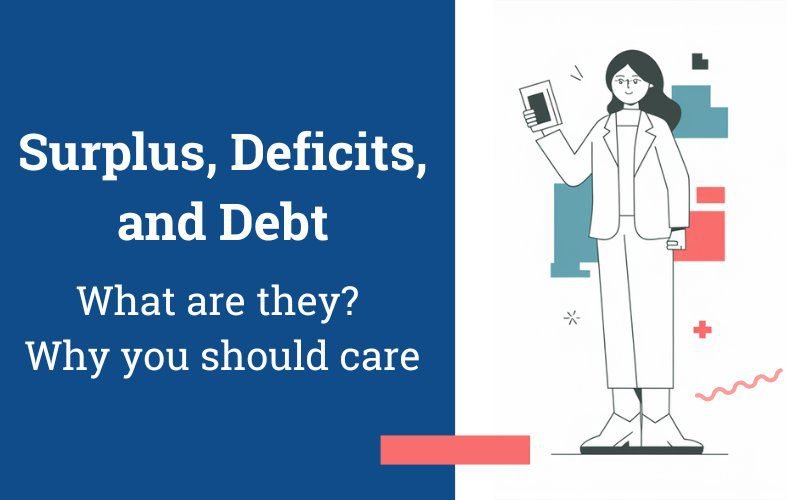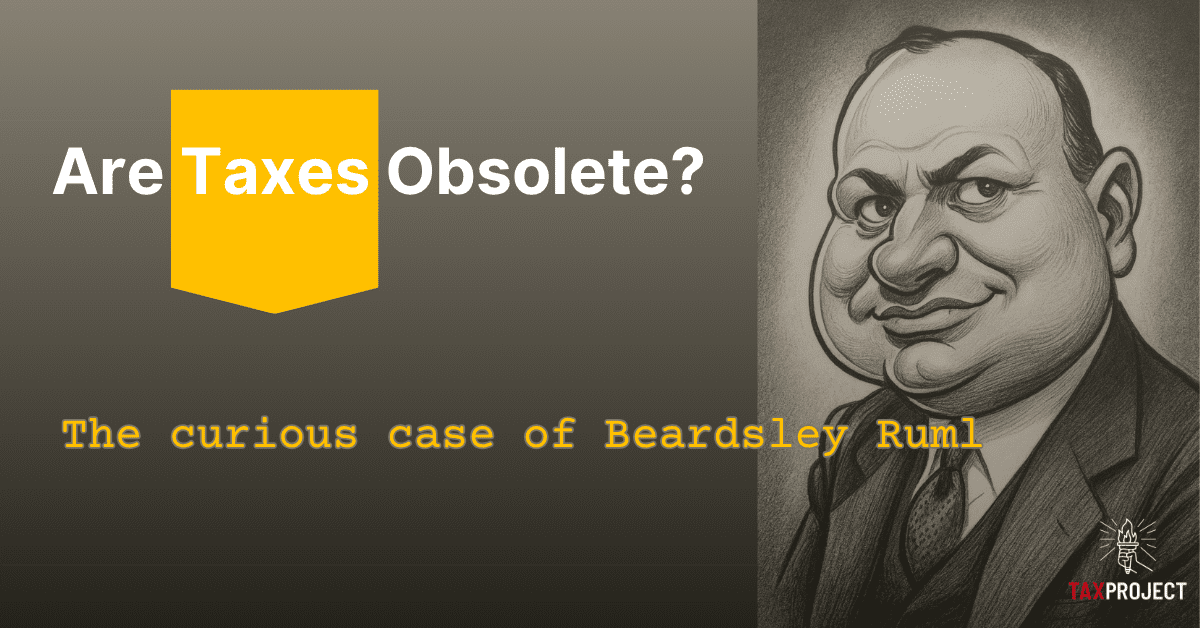The terms “surplus”, “deficit” and “debt”, or “National Debt”, are often used at the same time, and sometimes interchangeably, but they represent distinct concepts in government finance. Understanding the difference is crucial for grasping the fiscal health of our nation. This article discusses the differences, helps define them and put them in terms Citizens can use.
What is a Surplus & Deficit?
Imagine your household budget for a given period, say a month. You have money coming in (your income) and money going out (your expenses).
Deficit: If in that period you spend more money than you earn, you have a deficit. You’ve spent more than your current income . For a government, a budget deficit occurs when its total expenditures (spending on programs, services, etc.) exceed its total revenues (money collected from taxes, fees, and other sources) within a specific fiscal year (typically October 1 to September 30 in the U.S.) [3]. That is to say Total Expenses exceed Total Revenue.
Deficit
- Inadequacy or insufficiency. “a deficit in revenue.”
- The amount by which a sum of money falls short of the required or expected amount; a shortage. “budget deficit.”
- Deficiency in amount or quality; a falling short; lack. “a deficit in taxes, revenue, etc.”
Surplus: Conversely, if you earn more money than you spend in a given month, you have a surplus. The government experiences a budget surplus when its revenues exceed its expenditures in a fiscal year. This means that your Total Revenue exceeds your Total Expenses and you have money left over [3].
Surplus
- Being more than or in excess of what is needed or required: synonym: superfluous. “surplus revenue.”
- Being or constituting a surplus; more than sufficient. “surplus revenues; surplus population; surplus words.”
- An amount or quantity in excess of what is needed.
What is a National Debt?
Now, let’s extend that household analogy. If you consistently spend more than you earn each month, you’ll likely need to either a) Reduce Spending, b) Increase Revenue, c) Take from Savings, or d) Borrow money (use credit). Your use of credit might be a credit card, a loan from a bank, or borrowing from friends and family. This accumulated borrowing represents your total debt.
National Debt: The National Debt (or public debt) is the cumulative total of all the money the federal government has borrowed over its entire history to cover past deficits, minus any surpluses [1, 3]. When the government runs a deficit, it has to borrow money, usually by issuing Treasury bonds, bills, and notes. This new borrowing adds to the National Debt. When it runs a surplus, it can use that extra money to pay down a portion of the existing debt, or put into funding other programs and services.
While the US Government has mechanisms that you and I don’t have that make it different than a Credit Card, for our analogy the National Debt accumulates like the total balance on your credit card or loan statement, which reflects all the outstanding purchases (expenses) you’ve made over time and haven’t fully paid off (debt). Every time you have a monthly deficit (spend more than you earn and put it on credit), your overall credit card debt increases.
Debt
- Something owed, such as money, goods, or services.”used the proceeds to pay off her debts; a debt of gratitude.”
- An obligation or liability to pay or render something to someone else.”students burdened with debt.”
- The condition of owing. “a young family always in debt.”
National Debt and Deficits in Context, why does it matter?
For the United States, carrying some debt is nothing new, with rare exception the U.S. has carried debt since its inception [2]. Carrying some debt is normal, and perhaps beneficial – say like a Mortgage and a Credit Card bill you pay each month. However, the scale and trajectory of the US National Debt have dramatically changed over the last few years. The US has had some economic shocks that increased the debt rapidly including the 2008 Great Recession, and the COVID Pandemic. What is different now with our current National Debt is that it is the highest it has ever been ($36.95 Trillion) [10] greater than our entire country’s annual economic output of $29.18 trillion in 2024 (Debt to GDP > 100%) [11]. Troubling is that this is a peace time debt surpassing World War II levels of spending. To some, more concerning is that each year we have a deficit in our budget, now exceeding over a trillion dollars annually, that appears to be a structural shortfall. Meaning, the government’s revenue is consistently below its expenses and commitments that isn’t one time or transient, and must borrow each year to meet its funding needs.
The last time the U.S. federal government ran an annual budget surplus was in 2001 [1, 3]. Since then, the nation has experienced a continuous string of deficits (over 20 years in a row). This persistent pattern isn’t just a result of temporary economic downturns; it’s driven by structural deficits.
Structural deficits refer to a persistent imbalance between government spending and revenues that exists even when the economy is operating at its full potential (i.e., not in a recession, or major economic shock) [1, 3]. These are not caused by the ups and downs of the business cycle but by fundamental, long-term mismatches in revenue and expenses [3]. Key drivers of structural deficits in the U.S. include:
- Aging Population: As the population ages, programs like Social Security and Medicare face increasing demands, leading to higher spending. Fewer working-age individuals contribute taxes relative to the growing number of retirees receiving benefits [1].
- Rising Healthcare Costs: Healthcare costs consistently outpace economic growth, putting upward pressure on government spending for programs like Medicare and Medicaid [1].
- Tax Policies: Decisions to cut tax rates without corresponding spending reductions, or a tax base that doesn’t keep pace with the modern economy, can contribute to insufficient revenue.
- Increased Spending Commitments: Long-term commitments to various government programs and services, without sustainable funding mechanisms, create an ongoing gap.
These underlying factors mean that even during periods of economic prosperity, the U.S. government is projected to continue spending more than it collects, contributing to the ever-growing national debt [1].
Are Deficits Bad? What about Interest?
Deficits, and Debt spending are not all bad. Government can step in to “prime the pump” in times of economic turbulence to smooth a business cycle, and some government investments add to overall productivity. However, while sometimes beneficial (e.g., during wars, pandemics, or severe economic crises to stimulate recovery), persistent and large deficits are generally not a good thing because they directly lead to a larger national debt, and a larger national debt brings its own set of challenges:
Increased Interest Payments: Just like you pay interest on your credit card debt, the government must pay interest on the National Debt [8]. As the debt grows, so does the amount of interest the government has to pay. If your credit card balance keeps growing, a larger and larger portion of your monthly payment goes just to interest, leaving less money to pay down the principal or for other essential spending.
Real-World Impact: For the U.S. federal budget, interest payments on the national debt have become one of the fastest-growing “programs” [8]. These payments are mandatory and siphon away funds that could otherwise be used for other programs like education, infrastructure, scientific research, defense, or reducing taxes [8]. In 2024 Interest expenses exceeded $1 trillion dollars, passing the US Military as the 3rd largest expense in the Federal budget [12].
Crowding Out Budget Items: As the Interest payments grow, if they get large enough it puts the government in a difficult situation. If they are unable offset the deficits with more Revenue they may be forced to reduce other programs, or add to the Debt compounding the challenge. This has the effect over time of crowding out other government expenses in order to pay the rising Interest expenses.
Higher Interest Rate Expenses: When the government borrows heavily to finance its deficits, it competes with private businesses for available capital in the financial markets [9]. This increased demand for capital can drive up interest rates from investors who are taking on more risk from a highly leveraged seller. Higher interest rates make it more expensive for the government to borrow money to finance the debt. This leads to increasing Interest expenses. For example if you’re constantly maxing out your credit cards, banks might be less willing to lend you money or increase your interest rate to compensate for their higher risk.
Reduced Fiscal Flexibility: A large and growing national debt limits the government’s ability to respond effectively to future crises (like recessions or natural disasters) or to make necessary investments [8]. With a significant portion of the budget already allocated to interest payments, policymakers have less room to maneuver. If your household expenses match your income, an unexpected medical emergency or job loss can be catastrophic if you have no financial buffer or ability to borrow more without extreme difficulty. This can lead to difficult choices, potentially requiring painful tax increases or spending cuts during times when economic stimulus or social support is most needed [8].
Risk of Fiscal Crisis: In extreme cases, if investors lose confidence in a government’s ability to manage its debt, they may demand much higher interest rates or stop lending altogether. This could lead to a fiscal crisis, where the government struggles to pay its bills, potentially causing economic instability, inflation, and a loss of trust in the nation’s financial system [8]. This situation is unlikely to happen in the US as the Reserve Currency in the World, and backed by the US Governments unlimited ability to tax.
US Advantages: The Reserve Currency and Fiat Money
It’s important to acknowledge that for countries like the United States, whose currency (the U.S. dollar) holds reserve currency status, there’s a unique advantage. As the world’s primary reserve currency, the dollar is widely used in international trade, finance, and as a store of value by central banks globally [5]. This creates a consistently high demand for U.S. Treasury bonds, even amidst large deficits, making it easier and often cheaper for the U.S. government to borrow money [5]. Foreign governments and investors are generally willing to lend to the U.S. at relatively low interest rates because U.S. Treasury securities are considered extremely safe and liquid [5]. However, this ability is not unlimited and we may get to a point where that is tested (See our article Return of the Bond Vigilantes).
Furthermore, because the U.S. government issues its debt in its own fiat currency (a currency not backed by a physical commodity like gold, but by government decree), it theoretically has the ability to “print” more money to pay its debts. This gives it a degree of flexibility that countries borrowing in foreign currencies do not possess [5].
However, most mainstream economists believe that while these factors allow for higher debt levels, they do not negate the long-term risks associated with persistent structural deficits and a continuously rising national debt. Even with the reserve currency advantage and the ability to issue debt in fiat currency, there are still significant potential downsides:
- Inflation: While printing money can address debt, doing so excessively without a corresponding increase in goods and services (productivity) can lead to inflation, eroding the purchasing power of the currency [7].
- Loss of Confidence: Even for a reserve currency, if debt levels become truly unsustainable or if the government appears unwilling to address its fiscal imbalances, investors could eventually lose confidence, leading to a depreciation of the currency and higher borrowing costs as demand moves away from the dollar.
- Intergenerational Equity: Accumulating massive debt effectively transfers the burden of repayment (through future taxes or reduced services) to younger and future generations.
It’s worth noting that a minority school of thought, known as Modern Monetary Theory (MMT), holds a different perspective. MMT proponents argue that a sovereign government, which issues its own fiat currency, is not financially constrained in the same way a household or business is [6]. They contend that such a government can always create enough money to meet its obligations and finance spending, as long as it avoids inflation [6]. From this viewpoint, the primary limit on government spending is the availability of real resources in the economy, not the ability to finance deficits [6]. While MMT has gained some academic traction, its policy prescriptions and core tenets remain largely outside the economic mainstream and are considered outside of the mainstream by most economists, who emphasize the importance of fiscal sustainability and the risks of unchecked government spending and debt [7].
Conclusion
In conclusion, surpluses are annual measures of revenue outpacing expenses, deficits are an annual measure of overspending, and the national debt is the cumulative total of all borrowing less surpluses. Persistent deficits lead to growing debt, which in turn leads to higher interest payments, potential crowding out of private investment, reduced fiscal flexibility, and an increased risk of economic instability. While the U.S. dollar’s reserve currency status and the nature of fiat currency provide certain advantages in managing debt, most economists agree that these do not make the nation immune to the long-term structural problems that large and growing deficits entail [13][14]. Addressing these long-term fiscal challenges requires difficult policy choices to ensure a sustainable economic future.
Citations
[1] ThoughtCo. (n.d.). History of the US Federal Budget Deficit. Retrieved from https://www.thoughtco.com/history-of-us-federal-budget-deficit-3321439
[2] TreasuryDirect. (n.d.). History of the Debt. Retrieved from https://treasurydirect.gov/government/historical-debt-outstanding/
[3] USAFacts. (n.d.). What is the federal government’s budget deficit?. Retrieved from https://usafacts.org/answers/what-is-the-federal-governments-budget-deficit-or-surplus/country/united-states/
[4] Peterson Foundation. (n.d.). New Report: Rising National Debt Will Cause Significant Damage to the U.S. Economy. Retrieved from https://www.pgpf.org/article/new-report-rising-national-debt-will-cause-significant-damage-to-the-u-s-economy/
[5] Xponance. (n.d.). A Macroeconomic Perspective: Reserve Currency Status and Persistent Trade Deficits. Retrieved from https://www.xponance.com/a-macroeconomic-perspective-reserve-currency-status-and-persistent-trade-deficits/
[6] Deskera. (n.d.). What is Modern Monetary Theory?. Retrieved from https://www.deskera.com/blog/modern-monetary-theory/
[7] Econlib. (n.d.). Was MMT influential?. Retrieved from https://www.econlib.org/was-mmt-influential/
[8] Peterson Foundation. (n.d.). Interest Costs on the National Debt. Retrieved from https://www.pgpf.org/programs-and-projects/fiscal-policy/monthly-interest-tracker-national-debt/
[9] Khan Academy. (n.d.). Lesson summary: crowding out (article). Retrieved from https://www.khanacademy.org/economics-finance-domain/ap-macroeconomics/ap-long-run-consequences-of-stabilization-policies/crowding-out/a/crowding-out
[10] US Treasury, Debt to Penny https://fiscaldata.treasury.gov/datasets/debt-to-the-penny/debt-to-the-penny
[11] BEA, GDP https://www.bea.gov/data/gdp/gross-domestic-product
[12] GAO, Federal Audit https://www.gao.gov/products/gao-25-107138#:~:text=Interest%20on%20the%20debt%20in,are%20properly%20authorized%20and%20recorded).
[13] CRFB Negative Implications of High Rising National Debt https://www.crfb.org/blogs/cbo-outlines-negative-implications-high-rising-national-debt
[14] CBO 2023 Long Term Budget Outlook https://www.cbo.gov/system/files/2023-06/59014-LTBO.pdf











